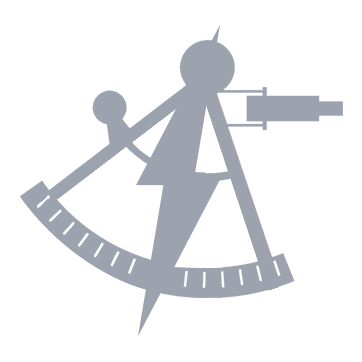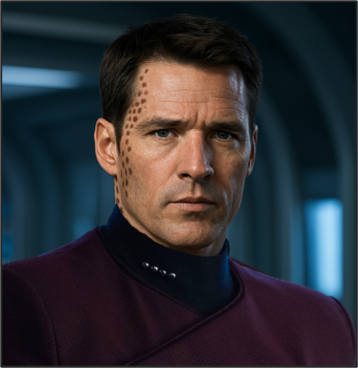Cadet Jeremy Ryan focused intently as he manually piloted the shuttle Sequoia through the simulated asteroid field. The projection shimmered on the viewscreen, the debris field ahead growing more chaotic with each passing moment. Behind him, Commander Mehta watched Ryan intently, hand resting on the back of the co-pilot’s chair.
“Increase maneuvering thrusters to eighty percent,” Mehta ordered, his tone serious, knowing the added difficulty the increased speed could cause the inexperienced pilot.
Ryan adjusted the RCS controls, the shuttle’s engines emitting a low whine as it pivoted to avoid an incoming asteroid. “Thrusters adjusted, course corrected,” he replied, his voice steady despite the sweat forming on his brow.
“Very good Cadet,” Mehta said, leaning forward slightly. “Now initiate a lateral sensor sweep and prioritize mineral deposits. Consider power management, you’re running low on reserves.”
Lieutenant Amir, seated at the tactical console, leaned back with a grin. “Careful, Cadet. You’ve got one of the toughest taskmasters in Starfleet watching your every move. Mehta loves precision scans. Anything less than perfection, and you’ll be scrubbing shuttle decks for a week.”
Ryan smirked but didn’t let his focus waver. “Activating sensor array,” he said, sweeping the area. Data scrolled across his console, and after a moment, he reported, “Detecting traces of dilithium and thorium isotopes. Marking coordinates.”
“Efficient,” Mehta remarked, nodding slightly. “Now, prepare for a mock distress call scenario. Amir, feed it into the system.”
Amir’s grin widened. “With pleasure, Commander.” He tapped his PADD, and an alarm blared through the shuttle. A simulated voice crackled over the comm system.
“— -ny ships withi—range. This is the transport ve—- Atlant– -e are caught in the grav—— -f a pulsar. Need immediate assist—–.”
Ryan’s hands flew over the controls, plotting a course to the source of the distress signal. “Adjusting heading. ETA to the target is four minutes,” he said. The urgency in his tone mirrored the simulated stakes.
“First breathe Cadet. Don’t just race toward the signal. Assess the environment,” Mehta said sharply. “What potential danger does the pulsar present?”
Ryan frowned and initiated a scan of the pulsar. “Extreme gamma radiation levels and massive irregular gravitational fluctuations detected,” he reported. “I’ll need to modulate the shields to compensate.”
“And the transport?” Mehta pressed.
Ryan quickly brought up a scan of the vessel. “The hull integrity is compromised. Life support is operational but failing. Six lifeforms detected, weak but alive, recommend immediate transport of survivors.”
Mehta nodded, his expression softening slightly. “Good analysis. Now, implement it.”
Ryan’s hands moved quickly over the controls, initiating a shield modulation protocol. The shuttle’s emitters hummed to life, a faint blue glow enveloping the hull. He plotted a careful approach vector, avoiding the pulsar’s gravity wells while bringing the damaged transport within transporter range.
“Transporter locks established,” Amir reported. “But the pulsar’s radiation is causing phase variance in the signal.”
“Can we use a narrow-band signal to minimize interference?” Ryan suggested, his voice calm but determined.
Amir raised an eyebrow, impressed. “Not bad, Cadet. Let’s see if it works.” He adjusted the controls, and moments later, a simulated transporter beam engaged, symbolically delivering the survivors safely to the shuttle.
Mehta stood straight and placed his hand on the Cadet’s shoulder with a grin, his gaze fixed on Ryan. “Well done, Cadet. You’re learning to think critically under pressure. But don’t get complacent. The real test is maintaining this level of performance consistently.”
Ryan nodded, his expression one of relief. “Understood, Commander.”
Mehta took the seat next to Ryan. “Alright, let’s set course for the rendezvous point. En route, we can finalize the final two training objectives.”
____________________________________________________________
The beeping, clanging, and calibrating of precision tools echoed through the expansive Transporter Room 1. Captain Day Renora crouched beside Chief Anari, her sharp hazel eyes scanning the exposed console with practiced precision. The transporter pad behind them cast a faint glow across the room, while many other systems were currently powered down during their upgrades, giving the scene an almost ethereal quality. Lieutenant Vex leaned over the opposite side, her athletic frame poised with energy, emerald green fingers tapping the display with rapid confidence.
“If we adjust the molecular imaging scanners to compensate for increased subspace variance,” Vex began, her Orion voice smooth but with a faint rasp, “we can reduce signal degradation by another three percent. It’s not perfect, but it’ll buy us critical seconds in high-interference zones.”
Chief Anari, petite, young, and practically vibrating with enthusiasm, flashed a bright grin. “That’s assuming the pattern buffers don’t fry from the data load. I’ve seen them pushed past their limits before. Turns out, Starfleet safety margins aren’t as generous as they claim.” The Denobulan Transporter Chief had proposed these upgrades, worried about the age and limitations of the Vallejo’s systems.
Day chuckled softly at the exchange, adjusting a power relay on the console. Day turned to the open comm channel to Engineering, “Valis, are you reading this?” she asked.
The Vulcan Chief Engineer’s reply came promptly, steady as a metronome. “I am, Captain. Chief Anari’s concerns are valid, but if we reroute the secondary power relays to the isolation manifold, the pattern buffers will remain within operational limits. I am making those adjustments now.”
Anari laughed lightly, her enthusiasm undampened. “Leave it to Valis to come up with the most logical solution!”
Day replied with a smirk. “Teamwork makes the transporters work. Let’s finalize these adjustments. We should be arriving in the Kavaria System soon.”
Vex secured the final calibration and glanced at the readout. “Diagnostics complete. Transporter system reporting optimal efficiency,” she confirmed, her voice edged with pride. “Good as new.”
“Better,” Anari corrected, brushing her hands off on her uniform with a satisfied nod. “Let’s hope it stays that way. Nothing tests upgrades like an actual mission.”
Before Day could respond, her comm badge chirped. “Rax to Captain Day. We’ve picked up a distress signal.”
Day tapped her badge with a sense of urgency. “Acknowledged. On my way.” She stood, her hazel eyes briefly meeting each of her team’s. “Great work, everyone. Valis, start a level five diagnostic of all transporter systems. I’ll be on the bridge.”
____________________________________________________________
The turbolift doors swished open, and Captain Day strode onto the Bridge of the USS Vallejo. Commander Bolik Rax rose from the First Officer’s chair, his Bolian features neutral but his posture alert. In the distance, Ensign Renn Tanara worked the Conn with her usual precision, while Lieutenant Loran, the Orion Operations Officer, monitored the consoles at the OPS station next to her.
“Captain on the Bridge,” Rax announced, stepping aside to give her his seat.
Day nodded briskly. “Report, Commander.”
“We’ve received an automated distress signal,” Rax began. “Lieutenant Loran picked it up a few minutes ago. He’s been analyzing the transmission.”
The Bajoran captain turned her attention to Loran. “Lieutenant, what do we know?”
The Orion focused on his console as he brought up the relevant data. “It’s an automated message, repeating on a Starfleet emergency frequency. The signal’s degraded, but intact enough to identify the source, the USS Tecumseh, NCC-14934.”
Day looked at Rax with a shrug turning back towards Loran. “The name doesn’t ring a bell. What can you tell me?”
“It’s an Excelsior-class starship that saw action in multiple conflicts. The Federation-Cardassian War, the Federation-Klingon War, and later, the Dominion War. During the latter, it was reported missing in action during the final days of the conflict and was presumed lost with all hands.” Replied Loran.
Day raised an eyebrow. “And yet here it is, sending out a distress call. What’s its last known location?”
Loran tapped a few more controls. “The signal’s originating from a dense nebula approximately 2.7 light-years from our current position. The nebula’s subspace conditions are causing severe interference, which might explain why we’re only now picking it up.”
Day turned to Rax. “Options?”
The Bolian First Officer folded his arms thoughtfully. “We’re only an hour or so out from the Kavaria system, but this could take precedence. If the Tecumseh’s distress signal is legitimate, there may still be lives at stake, we should investigate.”
Day nodded. “Agreed. Loran, can you pinpoint how long that signal’s been broadcasting?”
“Based on signal degradation and interference patterns, it’s nearly impossible. I’d say at least four days, but it could have been running for decades Captain, there’s no real way for me to tell from here,” Loran replied.
Day’s gaze hardened. “What about our ability to send a message back to the shuttle Sequoia? Can we warn them about the potential delay?”
Loran shook his head slightly. “Unlikely, Captain. The subspace interference in this region is affecting outbound communications. The automated distress signal uses a pre-recorded, highly repetitive burst transmission, it’s designed to cut through interference by sheer redundancy. Live communications, especially over the distances to reach the Sequoia, would be much harder to maintain.”
Rax added, “We could launch a probe and program it to transmit from the rendezvous point to update them, set it for a repetitive burst transmission as well.”
Day’s jaw tightened as she considered the options. “Lieutenant, program a class-6 probe with our status and instructions to remain in place in the Kavaria system if we’re not there when they arrive.”
“Understood, Captain,” Loran said, already programming the probe with instructions. After a few more commands into the OPS console he reported, “Probe launched.”
Day turned Ensign Renn at the Conn. “Ensign, set a course for the source of the signal. Loran, keep analyzing the message for any additional details. Renn, engage at warp eight.”
“Aye, Captain,” Renn replied, her hands gliding over the Conn controls.
The stars on the viewscreen stretched into the familiar streaks of warp travel. Day settled into the captain’s chair, her mind already anticipating the challenges ahead. She glanced at Rax.
“There’s no way there could be survivors after all this time,” Day said, her voice low.
“If there are,” Rax replied, his voice calm but skeptical, “we need to be ready for whatever kept them alive, or for whoever might have disabled the ship in the first place.”

 Bravo Fleet
Bravo Fleet










